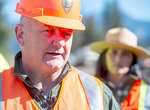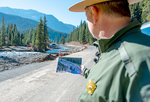Clear, 66° F
Four months from the day devastating June floods hit Yellowstone National Park, Superintendent Cam Sholly weaved his way through busy construction zones, checking on progress prior to …
This item is available in full to subscribers.
The Powell Tribune has expanded its online content. To continue reading, you will need to either log in to your subscriber account, or purchase a subscription.
If you are a current print subscriber, you can set up a free web account by clicking here.
If you already have a web account, but need to reset it, you can do so by clicking here.
If you would like to purchase a subscription click here.
Please log in to continue |
|



Four months from the day devastating June floods hit Yellowstone National Park, Superintendent Cam Sholly weaved his way through busy construction zones, checking on progress prior to Saturday’s reopening of the Northeast Entrance Road to park visitors.
The deep scars left in the wake of the flood were largely gone, yet workers in heavy machinery continued to finish temporary repairs to the road, including adding topsoil to surrounding landscape and preparing the road for paving. Only one of the areas washed away in the flood on the road remained unpaved going into Saturday.
“It’s been a long summer,” Sholly said.
He celebrated the effort, but said he originally had doubts the important road to gateway communities would be open before the end of the season.
“I think if you asked me June 13 —when we started seeing damage reports, and we were evacuating the park, and there was no power for 40 hours and 200,000 gallons of wastewater was dumping in the Gardiner River — If you ask me at that point, would we be standing here today, four months later, having the conversation that we’re having and seeing the repairs done that we’re seeing, I would have said that it’s probably not feasible,” he said.
The speed at which federal officials, park administrators, employees and contractors have worked to get temporary fixes in place has been unexpected, but has a toll in the level of exhaustion for all involved, Sholly said.
“Anytime you got a natural disaster, obviously you’re going to accrue a lot of overtime. The team is tired, there’s no question,” he said. “But they also recognized that it is very, very important to get it done.”
The Lamar River had to be diverted in at least three places to allow construction crews access to damaged areas. Near Trout Lake, the river sliced through hillsides, leaving shear drop-offs and creating a new river channel. It was the most taxing section to repair, Sholly said. He hopes crews can get the section paved in the next week, but it was bare gravel for Saturday’s opening. Weather is a big issue.
If the weather remains nice for the next few weeks, crews will be able to complete much of the remaining temporary fixes. But heavy snowfall, typical in Yellowstone during October, will slow or stop the work, he said.
While temporary repairs have gone much better than anticipated, a full recovery of infrastructure and changes made to avoid future flooding issues could take years, Sholly said.
“It may take a year; it may take 10 years to strengthen this corridor and to protect it from future floods,” he said. “This is a one-in-500-year flood event. I don’t even know what that means anymore. We could get another similar event next year.”
Officials face the decision to rebuild roads or to permanently move them. Sholly is hoping to make the Old Gardiner Road the permanent solution for the North Entrance. They have already spent about $25 million on the road and Sholly doesn’t want to gamble on rebuilding the road through the canyon. He said the flood event should serve as a “wake up call.”
“Most of this road was constructed in the 30s and 40s. Climate change wasn’t even part of the conversation at that point. And you know, these corridors are critical for multiple reasons. And it’s a reminder that not only do we need to maintain and improve the infrastructure that we have, but we’ve got to really look to the future when we’re making those improvements,” he said.
The park has already spent about $45 million on repairs to the Old Gardiner Road and Northeast Entrance Road. The Emergency Relief for Federally Owned Roads Program has paid for much of the work done to this point. Sholly said the initial stages of the recovery were done without overthinking the costs.
“We always pay attention to cost. But in this particular situation, we’re doing whatever we need to get these repairs completed on time,” he said.
The work has been monumental. One statistic that shows the size of the project; crews have already moved or brought “292,000 tons of material” in recovery efforts.
“And there’s more to come,” Sholly said.
There is also significant damage to the park’s waste water system. The park was fortunate to have some percolator ponds available, originally built in the 1960s. They were able to trench to those ponds and diverted the wastewater that was flowing in the Gardiner River. Sholly said it worked well, but only until the snow flies.
“It works well when the temperature is above freezing, but it doesn’t work well when it’s below freezing unless you want to go out and break ice every morning,” he said.
The cost of permanent repairs to infrastructure could dwarf the cost of temporary repairs. The park plans to continue with three major projects planned prior to the flood, including the removal and replacement of the Lewis River Bridge, refurbishing 22 miles of the Grand Loop Road between Old Faithful and West Thumb, and replacement of the Yellowstone River Bridge. Two of three projects will include overnight closures for certain periods during the summer and two projects will linger for more than a year. The Yellowstone River Bridge project is scheduled to be finished in 2025.
Despite the long list of work to come, Sholly took time to thank those who have helped get the roads repaired and the park open.
“I commend the collective efforts of the National Park Service, the Federal Highway Administration and Oftedal Construction, Inc. to complete this monumental task in such a short amount of time,” he said in a Friday press release.